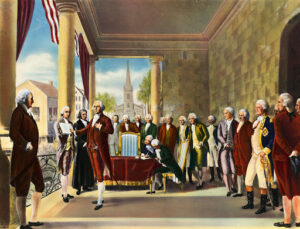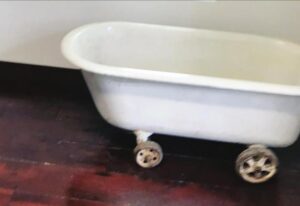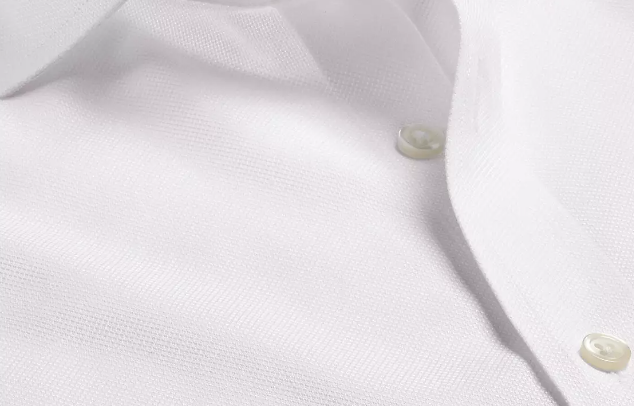Raboyseyee and Ladies,
The White Robe & White Shirts
Several years ago, the heylige Ois came across this headline in the Mishpacha Magazine: A non-Jewish millionaire in rural England is dictating the yeshivah dress code from Lakewood to Gateshead to Israel. Read the entire story here: https://mishpacha.com/a-cut-above-3/
This past Monday the heylige Ois found himself in a discussion regarding the origins of the white shirt worn by many in orthodox and Chasidic circles on the heylige shabbis. Is the white shirt mandatory? Can one still be Jewish and religious if one dons a blue, or some other color shirt? Back to the white shirt soon.
Thousands of years before the first inauguration of George Washington as the first president of the United States was held on Thursday, April 30, 1789, on the balcony of Federal Hall in New York City, New York, the heylige Toirah -in this week’s parsha- in great and very colorful detail, describes the inauguration ceremony for the Mishkan and the kohanim whose job it was to manage the sacrifices that people brought daily. We shall get to them soon as well.

The emes is azoy: for the greater part of my life, I was under the impression that Parshas Tzav is mamish a repeat of last week’s parsha -and for the first 61 of 96 pisukim, it is exactly that. Ober, guess what? There is some new information and it involves very specific clothing, vestments, anointing oils, and the very first Jewish inauguration ceremony. It featured pubic bathing, anointment via a special oil mixture, the donning of unique vestments and more. More on that below too.
Welcome to the Shivas Yemei HaMiluim (the seven days of inauguration). What are those? Nu, had you paid attention in yeshiva instead of daydreaming about girls and other narishkite, or had you stayed in shul just a few more minutes before running out to join the kiddish club as if your life -at least your social life- depended on it, you too might have heard and learned that Parshas Tzav contains the step-by-step instructions for the great inaugural ceremony of the Mishkan project. After 4 and ½ parshas of instructions, including the actual construction by Betzalel and his team of artisans, it’s mamish in our parsha, where the RBSO tells Moishe to get personnel in place to handle day to day operations. The Mishkan was about to open for business. Aharoin and his sons were to undergo anointment and intensive training; think a soft opening for a full seven days before the Mishkan was to be fully operative.
The heylige Toirah tells us -see below for the actual text- that all the Yiddin came to the inauguration of the Mishkan to watch how Moishe anointed the Kohanim in oil, physically dressed them in their special clothes, and prepared them to work in the Mishkan. The Ois forgot to mention that first he needed to bathe them. Bathe whom? The Kohanim were instructed to stay in the Mishkan for seven days where they were to watch and learn the procedures for sacrificing the korbonis. Moishe himself was their instructor. These seven days are called the days of miluim. Once these days ended, the Kohanim were ready to begin their regular work in the Mishkan.
The entire nation watched as Moishe immersed them, clothed them in their priestly garments, sprinkled them with the anointing oil, and brought their korbanos. The entire nation came? All the Yiddin? All 600,000 men who left Mitzrayim? All, less the 3000 the RBSO eliminated for eygel (golden calf) participation? Along with women and children? Well, blow me down. Ober Rashi -of course- caught this and tells us azoy: This gathering of the Jewish people was one of the places where a large number of people occupied a very small place. This teaches us just how important and auspicious that occasion was. Gishmak! What happened next? Let’s read posik 6 below.
Moishe brought Aharoin and his sons forward and he immersed them in water.” And let us also read a number of pisukim, they are amazing!
וַיְדַבֵּ֥ר יְהֹוָ֖ אֶל־מֹשֶׁ֥ה לֵּאמֹֽר׃
יהו spoke to Moses, saying:
קַ֤ח אֶֽת־אַהֲרֹן֙ וְאֶת־בָּנָ֣יו אִתּ֔וֹ וְאֵת֙ הַבְּגָדִ֔ים וְאֵ֖ת שֶׁ֣מֶן הַמִּשְׁחָ֑ה וְאֵ֣ת ׀ פַּ֣ר הַֽחַטָּ֗את וְאֵת֙ שְׁנֵ֣י הָֽאֵילִ֔ים וְאֵ֖ת סַ֥ל הַמַּצּֽוֹת׃
Take Aharoin along with his sons, and the vestments, the anointing oil, the bull of sin offering, the two rams, and the basket of unleavened bread;
וְאֵ֥ת כׇּל־הָעֵדָ֖ה הַקְהֵ֑ל אֶל־פֶּ֖תַח אֹ֥הֶל מוֹעֵֽד׃
and assemble the community leadership at the entrance of the Tent of Meeting.
וַיַּ֣עַשׂ מֹשֶׁ֔ה כַּֽאֲשֶׁ֛ר צִוָּ֥ה יְהֹוָ֖ אֹת֑וֹ וַתִּקָּהֵל֙ הָֽעֵדָ֔ה אֶל־פֶּ֖תַח אֹ֥הֶל מוֹעֵֽד׃
Moses did as יהו commanded him. And when the leadership was assembled at the entrance of the Tent of Meeting,
וַיֹּ֥אמֶר מֹשֶׁ֖ה אֶל־הָעֵדָ֑ה זֶ֣ה הַדָּבָ֔ר אֲשֶׁר־צִוָּ֥ה יְהֹוָ֖ לַעֲשֽׂוֹת׃
Moses said to the leadership, “This is what יהוה has commanded to be done.”
וַיַּקְרֵ֣ב מֹשֶׁ֔ה אֶֽת־אַהֲרֹ֖ן וְאֶת־בָּנָ֑יו וַיִּרְחַ֥ץ אֹתָ֖ם בַּמָּֽיִם׃
Then Moses brought Aharoin and his sons forward and washed them with water.
וַיִּתֵּ֨ן עָלָ֜יו אֶת־הַכֻּתֹּ֗נֶת וַיַּחְגֹּ֤ר אֹתוֹ֙ בָּֽאַבְנֵ֔ט וַיַּלְבֵּ֤שׁ אֹתוֹ֙ אֶֽת־הַמְּעִ֔יל וַיִּתֵּ֥ן עָלָ֖יו אֶת־הָאֵפֹ֑ד וַיַּחְגֹּ֣ר אֹת֗וֹ בְּחֵ֙שֶׁב֙ הָֽאֵפֹ֔ד וַיֶּאְפֹּ֥ד ל֖וֹ בּֽוֹ׃
He put the tunic on him, girded him with the sash, clothed him with the robe, and put the ephod on him, girding him with the decorated band with which he tied it to him.
וַיָּ֥שֶׂם עָלָ֖יו אֶת־הַחֹ֑שֶׁן וַיִּתֵּן֙ אֶל־הַחֹ֔שֶׁן אֶת־הָאוּרִ֖ים וְאֶת־הַתֻּמִּֽים׃
He put the breastpiece on him, and put into the breastpiece the Urim and Thummim.
וַיָּ֥שֶׂם אֶת־הַמִּצְנֶ֖פֶת עַל־רֹאשׁ֑וֹ וַיָּ֨שֶׂם עַֽל־הַמִּצְנֶ֜פֶת אֶל־מ֣וּל פָּנָ֗יו אֵ֣ת צִ֤יץ הַזָּהָב֙ נֵ֣זֶר הַקֹּ֔דֶשׁ כַּאֲשֶׁ֛ר צִוָּ֥ה יְהֹוָ֖ אֶת־מֹשֶֽׁה׃
And he set the headdress on his head; and on the headdress, in front, he put the gold frontlet, the holy diadem—as יהוה had commanded Moses.
וַיִּקַּ֤ח מֹשֶׁה֙ אֶת־שֶׁ֣מֶן הַמִּשְׁחָ֔ה וַיִּמְשַׁ֥ח אֶת־הַמִּשְׁכָּ֖ן וְאֶת־כׇּל־אֲשֶׁר־בּ֑וֹ וַיְקַדֵּ֖שׁ אֹתָֽם׃
Moses took the anointing oil and anointed the Tabernacle and all that was in it, thus consecrating them.
וַיַּ֥ז מִמֶּ֛נּוּ עַל־הַמִּזְבֵּ֖חַ שֶׁ֣בַע פְּעָמִ֑ים וַיִּמְשַׁ֨ח אֶת־הַמִּזְבֵּ֜חַ וְאֶת־כׇּל־כֵּלָ֗יו וְאֶת־הַכִּיֹּ֛ר וְאֶת־כַּנּ֖וֹ לְקַדְּשָֽׁם׃
He sprinkled some of it on the altar seven times, anointing the altar, all its utensils, and the laver with its stand, to consecrate them.
וַיִּצֹק֙ מִשֶּׁ֣מֶן הַמִּשְׁחָ֔ה עַ֖ל רֹ֣אשׁ אַהֲרֹ֑ן וַיִּמְשַׁ֥ח אֹת֖וֹ לְקַדְּשֽׁוֹ׃
He poured some of the anointing oil upon Aharoin’s head and anointed him, to consecrate him.
וַיַּקְרֵ֨ב מֹשֶׁ֜ה אֶת־בְּנֵ֣י אַהֲרֹ֗ן וַיַּלְבִּשֵׁ֤ם כֻּתֳּנֹת֙ וַיַּחְגֹּ֤ר אֹתָם֙ אַבְנֵ֔ט וַיַּחֲבֹ֥שׁ לָהֶ֖ם מִגְבָּע֑וֹת כַּאֲשֶׁ֛ר צִוָּ֥ה יְהֹוָ֖ אֶת־מֹשֶֽׁה׃
Moses then brought Aharoin’s sons forward, clothed them in tunics, girded them with sashes, and wound turbans upon them, as יהו had commanded Moses.

Immersed them? In what? Was there a mikveh nearby? A bathtub on wheels? A readily available water source? In the midbar? Back to that soon. Let’s read the posik again: “Moishe brought Aharoin and his sons forward, and he immersed them in water. He placed the tunic upon him and girded him with the sash, clothed him with the robe…” The questions are azoy: Why would Moishe need to bathe these grown people? Were Aharoin and his sons incapable of bathing themselves? This is even more surprising given that everything was witnessed by the entire people! Let’s re-read the specific instruction. First, we read (above) that Moishe immersed Aharoin and his sons in a mikveh. He then dressed Aharoin with his Priestly vestments. Moishe anointed the Tabernacle and all of its vessels. Only then did Moishe dress Aharoin’s sons. Were they -based on the order- waiting unclothed until Moishe completed anointing the Mishkan? Were the boys just hanging around, if you chap? What’s pshat here? Did Aharoin stand naked before the entire nation? Why didn’t Moishe clothe the Kohanim prior to anointing the Mishkan?
Says the Rambam so gishmak, azoy: The Kohanim were a function of the Mishkan, akin to the vessels of the Mishkan. They drew their sanctity and sense of purpose from it. Therefore, prior to donning them with their vestments, thereby completing their consecration, Moishe first consecrated the Mishkan. The bottom line: seemingly, the Kohanim were vessels of the Mishkan. That being said, did all the Yiddin in attendance get to see Aharoin and his kids without clothing? Maybe it was taka a mikveh! Let’s go veyter.
The bottom lines: Aharoin and his sons did not come out of the womb with some sort of holier status; they were regular people. They didn’t come out of the womb dressed in all of their sacred vestments. By asking Moishe to direct this ceremony in front of the entire congregation, the RBSO showed the people that these Kohanim are no godlier than the rest. Instead, they were selected by the RBSO and such elevation would require the ritual bath, sacred vestments, and a specific ceremony, Prior to the inaugural ceremonies, Aharoin and his sons were just as mundanely human as everyone else in the camp. One might argue that Aharoin mamish required this cleansing following his shtikel -if not more- involvement with the eygel caper. The bathing and anointing ceremony was yet another indication that the RBSO was ready to move on and allow Aharoin to overcome his own mistake. And the final bottom line: No human leader, ancient or modern, has ever been, or will ever be inherently spotless. Nor the rest of us; it’s just how the RBSO programmed us. Those selected by the RBSO have gotten a hall pass. In our times, they either get elected or are the beneficiaries of long-term contracts. As to the rest of us, well, we just need to pick up the pieces, shower or bathe ourselves, and start over. Veyter!
As part of the inaugural ceremonies Moishe sacrificed the special Ale-HaMiluim (inaugural ram), designated for this occasion. Moishe took the sacrificial parts of the ram, along with an assortment of loaves, oil, and fats, and placed them all into the waiting hands of Aharoin and his sons as a “Tenufa,” (a wave service) to the RBSO. He then took it back and burned it on the Mizbeyach as a “rei’ach nichoach La Shem, a pleasant aroma to G-d.”
Let us review: The back end of the parsha (chapter 8) describes the seven-day milu’im (consecration) process throughout which Moishe -acting as a koihen himself- performed the avoida, the priestly service. Ober, was Moishe a koihen? Or, but acting as one?
Says the medrish citing the heylige Gemora (Zevochim 102A) that the RBSO originally intended to appoint Moishe and his descendants to be kohanim. Ober, that plan went awry when Moishe repeated refused to lead the Yiddin out of Egypt. His job offer was rescinded and the priesthood transferred over to his brother Aharoin. That being stated, in our parsha, during the inaugural and dedication services, Moishe did serve as the koihen, but did not wear the special garments of the koihen during his one-week service. As an aside, says the heylige Gemora (Zevochim 17b) that should a real koihen not wear the designated special clothes while serving in the Temple, his service is rendered invalid.
Ober (however), if Moishe wasn’t wearing the priestly vestments, what was he wearing? Was he there in his jeans? Taka an excellent question and Rashi (8:28) -always one step ahead- tells us azoy: Quoting the heylige Gemora (Avoida Zoro 34a), he informs us that Moishe did not perform the avoida while wearing the regular priestly vestments, but rather, while wearing a plain white robe. Let’s check out the Gemora, why not?

ויקטר המזבחה. מֹשֶׁה שִׁמֵּשׁ כָּל שִׁבְעַת יְמֵי הַמִּלּוּאִים בְּחָלוּק לָבָן (עבודה זרה ל”ד) — Moshe (though a non-kohen) was officiating during the seven days of installation [in a white garment]
Mamish in the middle of describing the entire inaugural process which involved immersion, the vestments and the sacrificing of at least one animal, Rashi stops the presses to tell us that Moishe was dressed in a white tunic. Why would Rashi include this information here? Why was he and why are we concerned with Moishe’s attire at this moment? What does the reader gain from the image of Moshe’s white robe, and how does it relate to the inaugural ram? Is white then the choice of color while performing a service? Does davening replace the service the Yiddin performed back then? Many say yes and shoin; the white shirt may have been born in this week’s parsha. Gishmak, even if not factual.
Ober, what’s taka pshat here? Is that why we -some of us- were raised to wear white shabbis-shirts? Why do we need to know what Moishe was wearing and why davka white? Let’s read what the Ois found on this side topic. According to some, it’s taka an ancient tradition to wear white on the heylige shabbis, a practice seemingly popularized by Kabbalists. In reality, the primary obligation is to wear special clothing for the heylige shabbis: clean, laundered, and superior to our weekday clothing. Says the heylige Gemora (Shabbos 113b) that we honor shabbis by not wearing the same clothing on shabbis that we wear during the week.
Some say that clothing is a but concession for human weakness. Did Odom and Chava (Adam and Eve) wear clothing when prancing around the Garden of Eden? Initially not; they were naked mamish? Clothing was only fashioned for them -by the RBSO Himself- following their transgression of chapping what was forbidden. The bottom line: being naked led to the big sin. The lesson: keep your pants on! And for the shabbis tish, this: The Hebrew word begged (clothing) comes from the root baggad, meaning “to betray.”
On the other hand, many sources (including 1Mateh Moishe 414; Kitzur Shlah 135) the Ois dug up seem to imply that white is the preferred color for shabbis clothing and read on to find out just why. As an aside, by white, it may mean the entire outfit was white. You will still find a few in jerusalem in this color on the heylige shabbis. This was -according to both the Be’er Heitev, OC 262 and the Kaf Hachaim, OC 262:4- the custom in Talmudic times. And says the Arizal that one should wear four white garments on the heylige shabbis, which are intended to correspond to the four-letter “Shem Havaya” (the RBSO’s ineffable name). But wait, there is more, the best for last! It is also taught that wearing white clothes on Shabbis atones for sins of a sexual nature. Who says that? Check out the Mahram Chagiz 543. And now you know. Is it my imagination or does everything we do, say, and practice, somehow relate back to sins of a sexual nature? Shoin, let’s not go there. What was up with those people? Why were sexual sins always at the root of every issue? Are we different in our times? Ver veyst?

The bottom line: The Shulchan Aruch (OC 242:1; Mishna Berura 242:1,5) states that one should wear nice clothing on the heylige Shabbis. There is no mention of a color preference. Other authorities seem to say that the color of one’s clothing is unimportant, and one should simply follow local custom. More good news: the entire discussion revolves around outer clothing; must one wear white underwear on Shabbis? The bottom line: One need not have specifically designated undergarments for Shabbis though it is commendable not to wear any item of clothing on Shabbis that one wears on weekdays. The Kabbalists (Kaf Hachaim, OC 262:24) teach that the quality of the clothes we will be given in the World to Come will correspond to the quality of the clothes we wore on the heylige shabbis in our lifetime. Clothing, perhaps designer, in the world to come? Who knew?
A gittin Shabbis!
The Heylige Oisvorfer Ruv
Yitz Grossman
